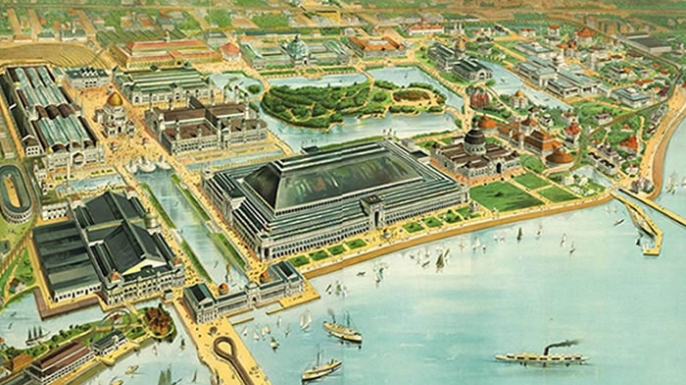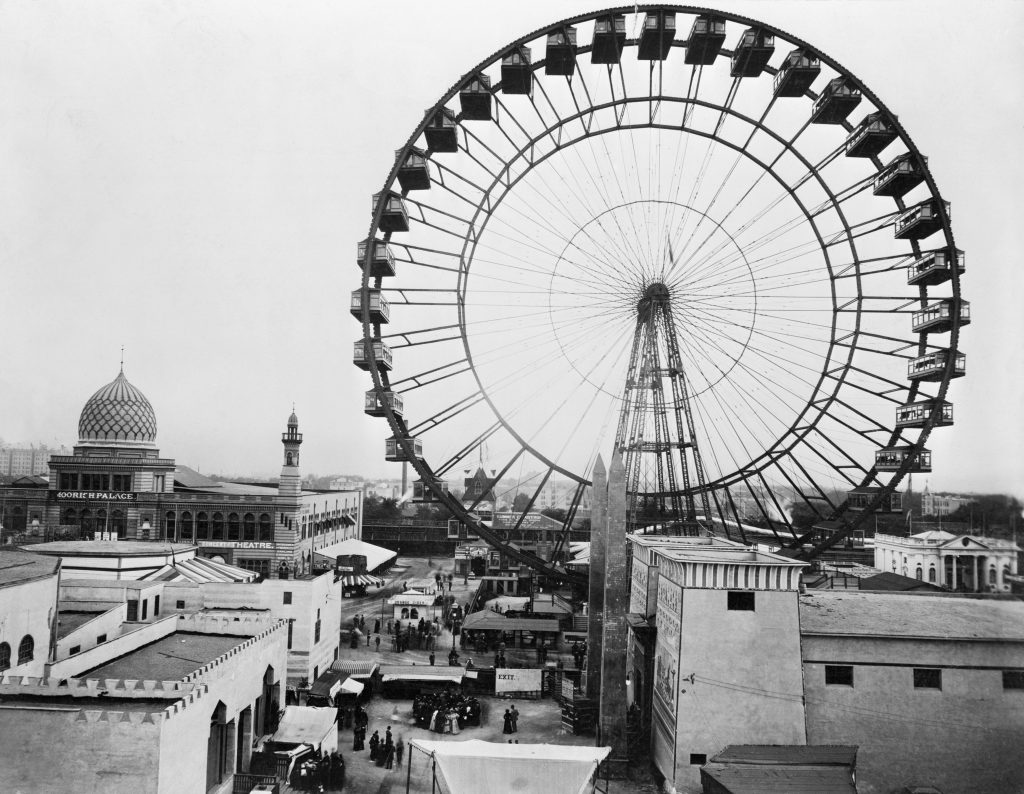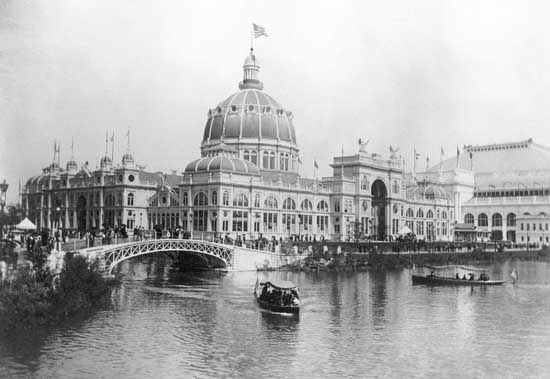In 1893, Chicago held a world’s fair called the World’s Columbian Exposition. The purpose was to celebrate Christopher Columbus’s arrival in The New World 400 years before in 1492. Beginning on May 1, 1893, the fair attracted over 27 million visitors until it closed on October 30. The fair was home to George Ferris’s new Ferris Wheel and many other new inventions.
During the early 1880s, the idea of hosting an event to celebrate Columbus’s landing in The New World first began to spread. Some of the country’s largest cities like Chicago, New York City, Washington D.C., and St. Louis expressed their interest in hosting the fair. The economy was not very stable at the time, and these cities saw hosting such an event as a way to gain more commercial profits and real estate sales. By 1890, Congress realized they would have to decide which city would be best for the event. New York City and Chicago were seen as the two best options, and it was just a matter of which one of those would be chosen. In hopes they would host the world fair, $15 million was pledged by New York City civic leaders if they hosted the fair. It was decided on Chicago though when Lyman Gage, a successful banker in Chicago, was able to raise millions of dollars over the course of a day. In fact, Gage was able to raise more than New York City’s $15 million!
Jackson Park was selected early on as the fair’s location. The Director of the fair was chosen to be Charles H. Wacker. Daniel H. Burnham was the director of works while George R. Davis worked with him as the director-general. The Rand McNally Building served as the fair’s headquarters. Burnham, deciding that architecture and sculpture were to be the fair’s main points, chose Frederick Law Olmstead to create the grounds. G. Brown Goode, a smithsonian worker, aided Davis with the exhibits. In 1889, Paris had held a world’s fair with the popular Eiffel Tower, and they wanted to have something that would make their fair distinctive. Many other top architects were chosen to take part in the project. Because of the neoclassical architecture, the fair earned the name “White City”.
On May 1, 1893, the World’s Columbian Exposition opened. Each of the forty-six nations in attendance had chosen their own delegate to represent them at the fair. This was also the first world fair to have national pavilions. Located in Jackson Park, the fair spanned was spread out over 630 acres. Over the next few months until it closed on October 30, 1893, the fair had over 27 million visitors from all over the world.
The fair was home to many carnival rides, and was the first world’s fair to have an area for amusements that was separated from exhibition halls. Of all the rides and attractions, George Ferris’s Ferris Wheel was by far the most popular, and nearly saved the fair from financial problems. It stood at 264 feet tall with thirty-six cars that could hold 40 people each. The Midway Plaisance was a park where the carnival rides were held, and was an inspiration to some of the first amusement parks in the U.S.
Of course, the Ferris Wheel was not the only attraction at the fair. Recreations of Columbus’s three ships, the Niña, the Pinta, and Santa Maria were built in Spain and very popular exhibits. Kirtland Cutter’s Idaho Building was another favorite, with about 18 million visitors. Lectures on the Science of Animal Locomotion were given by Eadweard Muybridge. He also used a zoopraxiscope to exhibit his motion pictures. Frederick Jackson Turner also gave lectures on the wild west. Popular belly dancer Little Egypt first introduced America to the style of dance. Moving walkways, seen today especially at airports, were also first introduced. Just outside of the exhibition, Buffalo Bill Cody held his own Wild West Show despite being told his exhibit was not welcome. Ottomar Anshüyz demonstrated his electrotachyscope and Louis Comfort Tiffany gained his reputation by the chapel he had done. There were popular anthropology and Eskimo exhibits created. Norway participated by exhibiting a replica of Gokstad ship called The Viking. There were so many displays it would take forever to list them all.
Architecture was one of the fair’s central focuses. The Court of Honor was called the White City because of the white neoclassical style buildings made of plaster, cement, and staff that had been painted white. Street lights were everywhere so the buildings could still be viewed and used once the sun had set. Fourteen main buildings called the “great buildings” surrounded a pool they called the Grand Basin. These buildings included: The Administration Building, Agriculture Building, Manufacturers and Liberal Arts Building, Mines and Mining Building, Electrical Building, Machinery Hall, Woman’s Building, Transportation Building, Fisheries Building, Forestry Building, Horticultural Building, and the Anthropology Building.
Today, the only remaining buildings for the fair are the Palace of Fine Arts and the World’s Congress Auxiliary Building. All buildings were only meant to be temporary and used solely for the duration of the fair. The Palace of Fine Arts is now the museum of Science and Industry. The Art Institute of Chicago then relocated into the Congress Auxiliary Building after the fair’s closing in October of 1893.
There were three buildings relocated. The Norway Pavilion is now in Blue Mounds, Wisconsin as a museum called Little Norway. The Maine State Building was relocated to Poland Spring, Maine after being purchased by the Ricker family and is now owned by the Poland Spring Preservation Society. Lastly, the Dutch House is located in Brookline, Massachusetts. Of all the exhibits, the only remaining one is The Viking. It is now exhibited in Geneva, Illinois and is open to visitors between April and October.
Originally, the White City was going to be touched up and left in Chicago, but most of the fair grounds had burned down in July of 1894.
Shortly before the fair had closed, Carter Harrison, Sr., Chicago’s mayor, was assassinated by Patrick Eugene Prendergast. Instead of the scheduled closing ceremonies, a memorial service was held for Harrison. The fair then closed on October 30, 1893 and Jackson Park was turned back into a public park.




